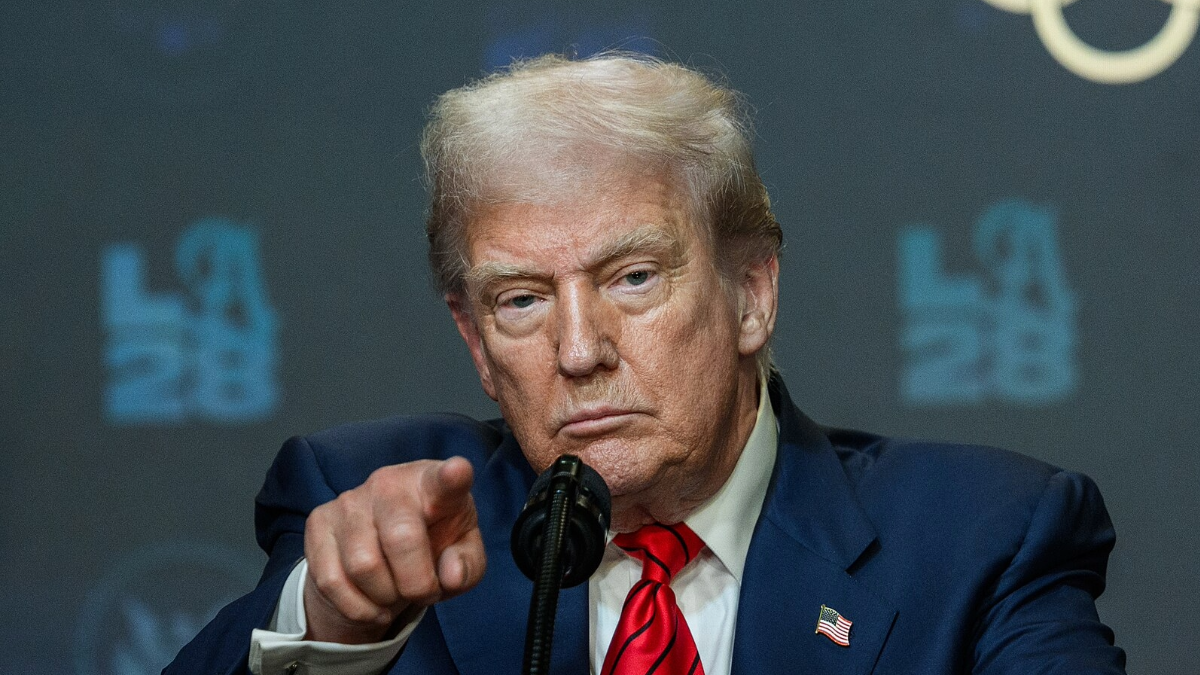Washington's Quest for AI Dominance Leaves Allies Between Rock and a Hard Place
Mark Scott / Aug 7, 2025Mark Scott is a contributing editor at Tech Policy Press.

President Donald Trump delivers remarks before signing an executive order creating a task force for the 2028 Los Angeles Olympics, Tuesday, August 5, 2025, in the South Court Auditorium of the Eisenhower Executive Office Building at the White House. (Official White House photo by Joyce N. Boghosian)
When the White House announced its long-awaited AI Action Plan in late July, the message to the wider world was clear. When it comes to the much-hyped emerging technology, allies and other countries should fall in line to embrace the United States’ “unquestioned and unchallenged global technological dominance.”
“American AI is open for business,” Michael Kratsios, director of the White House’s Office for Science and Technology policy, told digital ministers from several Asian countries on August 5. “We are ready to make deals under the dealmaker in chief.”
Yet Washington’s doubling down on American AI leadership — a policy that began during President Donald Trump’s first administration and that had continued during Joe Biden’s term in the White House — has placed long-time allies in a tough spot.
Countries from South Korea and Germany to Brazil and the Philippines spent decades supporting a US-led coalition that promoted free trade, democracy, fundamental rights, and mutual cooperation as the mainstays of the preferred global order. Amid the Trump administration’s efforts to reshape the global order under the prime directive to “Make American Great Again,” these long-standing international bonds have begun to fray — potentially beyond repair.
Most non-US policymakers and politicians still want to work with their American counterparts. Those intentions are based on decades of mutual benefit, economic development, and cultural bonds that won’t disappear overnight.
But the steady drumbeat of Washington’s “will they or won’t they” trade threats and unilateral diplomatic decisions on topics like how to handle Russia’s invasion of Ukraine, as well as the rise of new technological power centers around China, have made many officials in capitals worldwide reconsider what was, for decades, an indelible connection to the world’s leading democracy.
That geopolitical dilemma — either to stick with the US-led order or to twist to something new — lies at the heart of the White House’s recent AI Action Plan. Those proposals include domestic policies like freeing up land and energy to support scores of new AI-focused data centers, as well as international goals to cement a so-called US “AI tech stack” of services at the center of the next decade of global economic growth. That includes everything from AI-enabling infrastructure like data centers provided by US tech giants to large language models also created by the likes of OpenAI, Google, and Meta.
Once, countries would have jumped to sign up to those plans, hoping to piggyback on Silicon Valley’s innovation and even potential long-term funding or other incentives from US federal agencies.
But now, even Washington’s most ardent allies want to reconsider their options.
Do non-US policymakers want to promote American “global technology dominance” at a time when US officials have either been unwilling to uphold long-standing democratic principles within global digital policy discussions or have actively criticized decades-old partners for implementing domestic digital rules that, for many in Washington, represented unfair trade barriers to US firms?
It’s a tricky balance for long-term US allies between maintaining close ties with an increasingly polarized and isolationist Washington and forging a new path to create local AI alternatives that, inevitably, may run counter to American foreign policy ambitions.
The European Union, for instance, has unveiled billions of euros of new funding to support the growth of domestic AI products and services, while the likes of Japan and Australia have equally laid out proposals to support local artificial intelligence firms to compete on the global stage.
For European firms, Henna Virkkunen, the European Commissioner in charge of tech sovereignty, told the European Parliament, “the most important perspective is tech sovereignty; to build up European capacities when it comes to AI.”
For countries like South Africa and Indonesia from the so-called Non-Aligned Movement, the US’ vocal push to promote solely American AI offerings has also reignited interest in partnering with China, whose own global AI governance policies, at least on paper, are more open to international collaboration than the perceived “take it or leave” stance outlined in the White House’s AI Action Plan.
This international wariness toward American digital policymaking did not start with Trump 2.0.
During the previous Biden’s administration, US officials leaned hard on both the Netherlands and Japan to impose export controls on world-leading semiconductor manufacturing equipment over Washington’s fears that such machinery would fuel China’s technological rise. Trump’s first term in the White House also included heavy-handed diplomacy to cajole Western allies to give up contracts with Huawei, the Chinese telecommunications giant.
But the digital geopolitical landscape is different in 2025 than it was even four years ago.
Government officials outside the US now openly talk of decoupling from America on topics like AI, platform governance, and tech-enabled industry policy. Those conversations — framed around “technological sovereignty” — have sprung up in even the most ardent of US allies where local policymakers are wary of attaching their countries’ long-term interests to the world’s largest economy whose policy agenda can appear to shift, arbitrarily, from one day to the next.
Such potential “digital conscious uncoupling” could not come at the worst time.
Authoritarian governments, led by China and Russia, are pursuing aggressive tactics — embodied in the United Nations’ Convention Against Cybercrime — to embed mass surveillance, widespread suppression and government control over how technology develops.
Confronted with this widespread threat to the digital world, Western democracies must speak with one voice, and not become divided among themselves. Unfortunately, that is now unlikely as Washington pushes MAGA policymaking and the US’ long-standing allies demur on signing up to a digital agenda that, for many, no longer meets their geopolitical needs.
Authors
